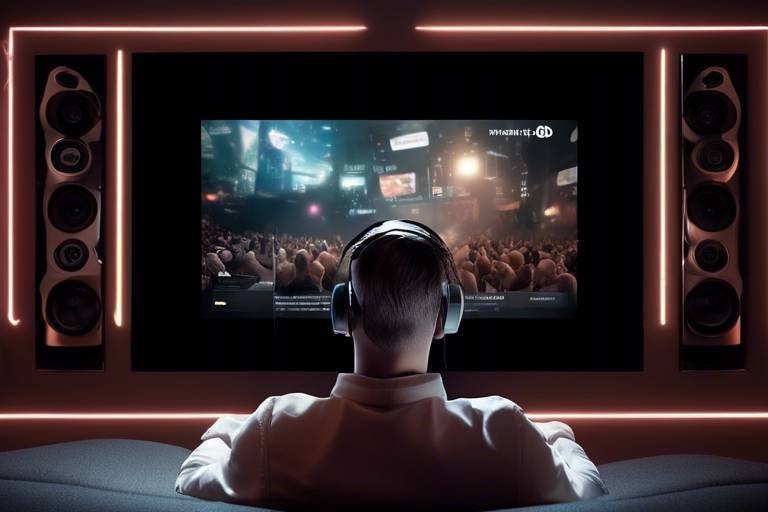The Evolution of Social Media - What’s Next?
Social media has come a long way since its inception, evolving from simple online communication tools to complex platforms that shape our daily interactions and influence global conversations. The journey of social media is akin to a roller coaster ride, filled with thrilling highs and challenging lows. As we delve into this fascinating evolution, we will uncover the pivotal moments that defined social media as we know it today and explore what the future holds for these digital spaces.
In the early days of the internet, social interaction was limited to basic chat rooms and forums. Platforms like Six Degrees, launched in 1997, allowed users to create profiles and connect with friends, laying the groundwork for what would eventually become modern social media. These early tools were rudimentary, but they sparked a desire for connection that would drive the development of more sophisticated platforms. The emergence of Friendster and MySpace in the early 2000s marked a significant turning point, as they introduced features such as friend lists and customizable profiles, attracting millions of users and setting the stage for the social media explosion that followed.
As the digital landscape evolved, so did the platforms that dominated it. Facebook, founded in 2004, revolutionized social networking by allowing users to share updates, photos, and life events with friends and family, creating a sense of community that resonated with millions. Twitter followed suit in 2006, introducing the concept of microblogging, where users could share thoughts in 280 characters or less. Meanwhile, Instagram burst onto the scene in 2010, focusing on visual content and quickly becoming a favorite among younger demographics. Each platform brought unique features to the table, but they all shared a common goal: to connect people in meaningful ways.
Over the years, user engagement on social media has transformed dramatically. Initially, interactions were limited to posts and comments, but today, engagement encompasses a wide array of activities, including likes, shares, and stories. This evolution has given rise to trends that define our social media experience:
- Content Sharing: Users are not just consumers of content; they are creators, sharing their lives and interests with a global audience.
- Real-Time Interaction: Platforms now allow for live streaming and instant feedback, making conversations more dynamic and engaging.
- Community Building: Niche groups and interests have flourished, allowing users to connect over shared passions.
One of the most significant developments in social media has been the rise of influencers. These individuals have harnessed their online presence to build brands and engage with followers on a personal level. Their ability to connect with audiences has transformed traditional marketing strategies, leading brands to collaborate with influencers for authentic promotion. This shift has not only changed the way products are marketed but has also redefined the relationship between consumers and brands, making it more personal and relatable.
Social media has democratized content creation, enabling anyone with a smartphone to share their voice and creativity. Platforms have evolved to support multimedia content, allowing users to create and share videos, podcasts, and visual art with ease. This shift has empowered ordinary users to become content creators, leading to a diverse range of perspectives and experiences being shared globally. The line between consumer and creator has blurred, and this trend is only expected to grow in the future.
Algorithms play a crucial role in shaping user experiences on social media. They determine what content is seen, how often it appears, and who gets to engage with it. While algorithms can enhance user experience by showing relevant content, they also raise concerns about echo chambers and the manipulation of information. Understanding the impact of algorithms is essential for users to navigate the ever-changing landscape of social media.
Despite its many benefits, social media is not without its challenges. Issues such as privacy concerns, misinformation, and the impact of online harassment have sparked heated debates about the responsibilities of platforms and users alike. As we continue to engage with these platforms, it’s crucial to address these challenges head-on to create a safer and more inclusive digital environment.
With the rise of data breaches and privacy scandals, user trust has been shaken. Social media platforms are under increasing pressure to enhance data security measures and protect user information. Users must also take responsibility for their privacy by understanding the settings and features available to them. It's a two-way street, and both platforms and users must work together to ensure a secure online experience.
The spread of misinformation on social media has significant implications for public discourse. As false information can easily go viral, platforms are now taking steps to combat this issue through fact-checking and user education. However, the responsibility also lies with users to verify information before sharing it, fostering a culture of critical thinking and informed engagement.
As we look ahead, the future of social media promises to be exciting and unpredictable. Emerging technologies such as artificial intelligence and virtual reality are set to redefine how we connect and communicate online. We may witness a shift towards more immersive experiences, where users can engage in virtual spaces that mimic real-life interactions. Additionally, changing user behaviors and preferences will likely shape the evolution of platforms, prompting them to adapt and innovate continuously.
- What is the first social media platform? The first social media platform is often considered to be Six Degrees, launched in 1997.
- How has social media impacted marketing? Social media has transformed marketing by enabling brands to engage directly with consumers and leverage influencers for authentic promotion.
- What are the main challenges facing social media today? Key challenges include privacy concerns, misinformation, and online harassment.
- What does the future hold for social media? The future may include more immersive experiences through technologies like AI and virtual reality, along with evolving user behaviors.

The Birth of Social Media
The journey of social media is as fascinating as it is complex, tracing back to the early days of the internet when the idea of connecting with others online was just a dream. In the late 1970s and early 1980s, the first forms of online communication emerged, primarily in the form of bulletin board systems (BBS). These platforms allowed users to connect via dial-up modems, sharing messages, files, and ideas. Can you imagine the excitement of seeing your thoughts echoed back from someone miles away?
Fast forward to the 1990s, and the landscape began to shift dramatically with the introduction of platforms like Six Degrees, which allowed users to create profiles and connect with friends. This was a pivotal moment in the birth of social media, as it laid the groundwork for the interconnected networks we know today. Think of it as the first seed planted in the vast garden of social networking, which would soon flourish into a multitude of platforms.
As the internet became more accessible, the early 2000s saw the rise of social networking sites like Friendster and MySpace. These platforms introduced innovative features such as customizable profiles and the ability to share multimedia content, which captivated users and encouraged them to express themselves in new ways. It was during this time that the term "social media" began to gain traction, signifying a shift in how we communicated and interacted online.
The evolution of social media didn't stop there. In 2004, Facebook launched, revolutionizing the way people connect. With its user-friendly interface and focus on real-life connections, it quickly became the go-to platform for sharing life updates, photos, and experiences. Twitter followed shortly after in 2006, introducing the concept of microblogging, where users could share thoughts in 140 characters or less. This brevity became a hallmark of social media communication, making it easier than ever to stay updated on current events and trends.
As social media continued to evolve, it became clear that these platforms were not just tools for communication; they were reshaping society itself. The ability to connect with friends and family across the globe, discover new interests, and engage with diverse communities transformed the way we perceive relationships and social interactions. It’s almost like social media became a new language, one that transcends borders and cultures.
Today, as we reflect on the birth of social media, it’s essential to recognize the profound impact it has had on our lives. From fostering connections to influencing political movements, social media has become an integral part of our daily existence. As we dive deeper into the evolution of these platforms, we’ll explore how they have grown and adapted to meet the ever-changing needs of users.
- What was the first social media platform? The first social media platform is often considered to be Six Degrees, launched in 1997.
- How did social media change communication? Social media made communication faster and more accessible, allowing people to connect globally in real-time.
- What are some early forms of online communication? Early forms included bulletin board systems (BBS) and chat rooms, which allowed users to share messages and files.

The Rise of Major Platforms
The evolution of social media has been nothing short of revolutionary, marking a significant shift in how we communicate and interact with one another. With the advent of the internet, platforms began to emerge that would forever change the landscape of online interactions. From the early days of simple message boards and chat rooms, we have witnessed the birth and rise of powerful social media giants like Facebook, Twitter, and Instagram. Each of these platforms has its unique features that cater to different aspects of social interaction, making them integral to our daily lives.
Facebook, launched in 2004, was initially designed for college students. However, it quickly expanded to the general public, becoming a global phenomenon. Its ability to connect people from all walks of life, along with features like groups, events, and a robust news feed, allowed users to share their lives and interests in ways never before possible. The platform's emphasis on building connections has made it a virtual community for billions, where users can share their thoughts, photos, and experiences in real-time.
Twitter, on the other hand, introduced a different approach to social media with its character limit and real-time updates. Launched in 2006, it became the go-to platform for breaking news, instant updates, and concise communication. The concept of hashtags and trending topics transformed how information spreads, allowing users to engage in global conversations with just a few keystrokes. It’s fascinating to think how a simple tweet can spark movements or change public opinion almost overnight.
Then we have Instagram, which burst onto the scene in 2010, focusing on visual storytelling. With its emphasis on images and short videos, Instagram has captivated a younger audience, allowing users to express themselves creatively through photos, filters, and stories. The platform has not only redefined how we share moments but has also become a lucrative space for brands and influencers to showcase their products and lifestyles, creating a new economy centered around visual content.
These platforms have not only shaped how we interact but have also influenced our behaviors and societal norms. For instance, the rise of the "like" button has transformed validation into a digital currency, affecting how users perceive their self-worth and social status. The competition for likes and shares has led to an explosion of content creation, with users striving to produce engaging posts that resonate with their audience. This phenomenon has led to a new era of marketing, where brands must navigate the complex landscape of social media to capture the attention of consumers.
As we delve deeper into the dynamics of these major platforms, it’s essential to consider the implications of their rise. The interconnectedness they provide has both positive and negative effects. While they foster community and connection, they also present challenges such as the spread of misinformation and the potential for online harassment. Understanding the duality of these platforms is crucial as we continue to navigate the digital age.
| Platform | Launch Year | Key Feature |
|---|---|---|
| 2004 | Social Networking | |
| 2006 | Real-time Updates | |
| 2010 | Visual Storytelling |
In conclusion, the rise of major social media platforms has transformed our communication landscape, giving us unprecedented access to information and connection. As we continue to engage with these platforms, it's essential to reflect on their impact and consider how they shape our interactions in both positive and negative ways. The digital world is ever-evolving, and understanding these dynamics will prepare us for the future of online communication.
- What was the first social media platform? The first recognizable social media platform is considered to be Six Degrees, launched in 1997.
- How do social media platforms make money? Most platforms generate revenue through advertising, sponsored content, and data monetization.
- What is the future of social media? The future may include more immersive experiences with the integration of virtual reality, augmented reality, and AI-driven content.

User Engagement and Trends
User engagement on social media has undergone a remarkable transformation over the years, evolving from simple text-based interactions to a vibrant tapestry of multimedia content and real-time communication. In the early days of platforms like MySpace and Friendster, users primarily connected through basic profiles and simple messaging. Fast forward to today, and we see a world where engagement is not just about connecting with friends but also about sharing experiences, ideas, and even lifestyles.
One of the most significant trends in user engagement is the rise of content sharing. Users are no longer passive consumers; they are active participants in creating and disseminating information. This shift has been catalyzed by the introduction of features such as stories, live videos, and reels, which encourage users to share their moments in real-time. For instance, Instagram's Stories feature allows users to post photos and videos that disappear after 24 hours, creating a sense of urgency and spontaneity that drives engagement.
Moreover, the concept of likes and comments has become fundamental to the social media experience. These metrics not only serve as a form of validation for users but also create a feedback loop that encourages more content creation. The more likes and comments a post receives, the more likely it is to be seen by others, leading to a snowball effect that can amplify a user's reach. This phenomenon is evident when we analyze the engagement metrics of popular influencers and brands, who often rely on these interactions to gauge their audience’s interests and preferences.
Interestingly, the way users engage has also shifted towards a more community-driven approach. Platforms like Reddit and Discord have capitalized on this trend by fostering niche communities where users can discuss shared interests. This sense of belonging and community engagement is a powerful driver of user loyalty and retention. For example, a study by the Pew Research Center found that users who participate in community discussions are more likely to stay active on the platform compared to those who engage only with their immediate social circle.
As we look to the future, it’s clear that user engagement will continue to evolve. The integration of artificial intelligence and machine learning is set to personalize user experiences even further, tailoring content to individual preferences and behaviors. This means that users will not only engage more but will also find themselves interacting with content that resonates deeply with their interests.
To summarize, the dynamics of user engagement on social media have shifted dramatically, characterized by:
- Increased Content Sharing: Users are more inclined to share their lives through various formats.
- Feedback Mechanisms: Likes and comments play a crucial role in encouraging content creation.
- Community Focus: Niche communities foster deeper connections among users.
- Technological Integration: AI and machine learning will further personalize user experiences.
As social media continues to grow and change, understanding these trends will be essential for anyone looking to navigate the digital landscape effectively. The future of engagement is not just about the number of followers or likes; it’s about building meaningful connections and fostering a sense of community in an increasingly digital world.
Q: How has user engagement changed on social media over the years?
A: User engagement has shifted from simple text interactions to a dynamic mix of multimedia content, community-driven discussions, and real-time sharing. Features like stories and live videos have made engagement more spontaneous and interactive.
Q: What role do likes and comments play in user engagement?
A: Likes and comments serve as crucial feedback mechanisms that encourage users to create more content. They also help increase a post's visibility, creating a snowball effect that can amplify engagement.
Q: How do niche communities influence user engagement?
A: Niche communities foster a sense of belonging among users, leading to higher loyalty and retention rates. Users who engage in discussions within these communities are often more active on the platform.
Q: What future trends can we expect in user engagement on social media?
A: The integration of AI and machine learning will personalize user experiences, making interactions more relevant and tailored to individual preferences, which will likely enhance engagement further.

In today's digital landscape, the impact of social media influencers cannot be overstated. These individuals, often regarded as trendsetters or thought leaders, have transformed the way brands connect with their audiences. It's fascinating to see how a simple post can lead to a surge in product sales or a significant shift in public opinion. But what exactly makes influencers so powerful?
First and foremost, influencers have cultivated a sense of trust with their followers. Unlike traditional celebrities, who may be seen as distant and unapproachable, influencers often share their personal stories, struggles, and triumphs. This authenticity allows them to forge deeper connections with their audience, making their recommendations feel more genuine. For example, a beauty influencer sharing their skincare routine is more relatable than a celebrity endorsing a product in a polished ad.
Moreover, influencers possess the ability to create engaging content that resonates with their followers. They understand the nuances of their audience's preferences and craft messages that are not only appealing but also shareable. This is where the magic happens—when followers share influencer content, it reaches a broader audience, amplifying the message and creating a ripple effect. Think of it as a modern-day word-of-mouth marketing strategy, but on a global scale.
As brands recognize the potential of influencer marketing, many are allocating a significant portion of their budgets to collaborate with these digital stars. According to recent studies, over 70% of marketers believe that influencer marketing is effective. This shift has led to the emergence of various types of influencers, categorized by their follower count:
| Type of Influencer | Follower Count | Characteristics |
|---|---|---|
| Nano Influencer | 1K - 10K | Highly engaged audiences, niche markets |
| Micro Influencer | 10K - 100K | Strong community connection, targeted reach |
| Macro Influencer | 100K - 1M | Broader reach, often professional influencers |
| Mega Influencer | 1M+ | Celebrity status, massive reach but lower engagement |
This table illustrates how brands can choose the right type of influencer based on their marketing goals. For instance, a startup may benefit more from partnering with a nano or micro influencer who has a highly engaged audience, while a well-established brand might opt for a macro influencer to maximize reach.
However, the rise of influencers isn't without its challenges. As the market becomes saturated, audiences are becoming more discerning. They can easily spot inauthentic promotions or endorsements that don't align with an influencer's established brand. This has led to a growing demand for transparency in influencer marketing, where followers expect clear disclosures when a post is sponsored.
In conclusion, the impact of social media influencers is profound and multifaceted. They not only shape consumer behavior but also influence the very fabric of online culture. As we move forward, it will be intriguing to see how this dynamic evolves, especially with the emergence of new platforms and technologies. Will influencers continue to dominate the marketing landscape, or will a new wave of digital communication redefine their role? Only time will tell.
- What is the main role of social media influencers? Influencers promote products and services to their followers, leveraging their credibility and reach to drive engagement and sales.
- How do brands choose the right influencer? Brands consider factors such as follower count, engagement rates, audience demographics, and the influencer's niche to ensure alignment with their marketing goals.
- What are the challenges faced by influencers? Influencers face challenges like maintaining authenticity, managing audience expectations, and navigating the complexities of sponsored content disclosures.

Content Creation and Sharing
In today's digital age, the way we create and share content has undergone a remarkable transformation. Gone are the days when content was solely the domain of professional creators. Now, anyone with a smartphone and an internet connection can become a content creator, sharing their thoughts, experiences, and talents with a global audience. This shift has not only democratized content creation but has also redefined the very essence of communication in our interconnected world.
The rise of platforms like YouTube, TikTok, and Instagram has paved the way for ordinary individuals to showcase their creativity. Whether it's a cooking tutorial, a dance challenge, or a travel vlog, the possibilities are endless. This has led to an explosion of user-generated content, where individuals can express themselves freely and connect with others who share similar interests. In fact, studies show that user-generated content can drive up to 79% of user engagement, making it a powerful tool for both personal expression and brand marketing.
As we dive deeper into the world of content creation, it's essential to recognize the various forms it can take. From videos and blogs to podcasts and memes, the diversity of content types allows creators to engage their audiences in unique ways. For instance, a travel blogger might share stunning photographs of their adventures, while a podcaster might delve into thoughtful discussions on relevant topics. This variety not only caters to different audience preferences but also encourages users to explore and interact with content across multiple platforms.
Moreover, the act of sharing content has become just as significant as its creation. Social media platforms have integrated features that allow users to like, comment, and share posts with their networks, amplifying the reach of individual creators. This interconnectedness fosters a sense of community, where users can engage in conversations, provide feedback, and even collaborate on projects. It's not uncommon to see creators teaming up for joint ventures, blending their audiences and ideas to create something truly unique.
However, with great power comes great responsibility. As more individuals engage in content creation and sharing, issues such as copyright infringement and content authenticity have emerged. Creators must navigate the fine line between inspiration and imitation while being mindful of the impact their content may have on others. Additionally, the challenge of standing out in a saturated market can be daunting. With millions of creators vying for attention, how does one ensure their content resonates? This is where understanding your audience and staying true to your voice becomes paramount.
To further illustrate the impact of content creation and sharing, consider the following table that highlights key statistics:
| Statistic | Impact |
|---|---|
| User-generated content drives engagement | 79% of users are more likely to engage with brands that share user-generated content. |
| Video content is highly favored | Video posts on social media generate 1200% more shares than text and image content combined. |
| Influencer marketing effectiveness | Influencer marketing can yield an ROI of up to 11 times higher than traditional forms of marketing. |
In conclusion, the landscape of content creation and sharing is vibrant and ever-evolving. As we embrace this new era of digital communication, it's crucial to recognize the power we hold as creators and consumers alike. By fostering creativity, encouraging collaboration, and promoting authenticity, we can continue to shape a dynamic online community that thrives on shared experiences and diverse perspectives.
- What is user-generated content? - User-generated content refers to any form of content, such as videos, blogs, or social media posts, created by individuals rather than brands or organizations.
- How can I start creating content? - Begin by identifying your interests and passions, choose a platform that aligns with your goals, and start sharing your unique perspective with the world!
- What are the benefits of sharing content on social media? - Sharing content can help you build an audience, connect with like-minded individuals, and even open up opportunities for collaboration and monetization.

The Role of Algorithms
When we think about social media, we often picture vibrant photos, witty tweets, and viral videos. But have you ever stopped to consider the invisible forces driving what you see on your feed? That’s right—algorithms! These complex mathematical formulas are like the secret sauce behind your social media experience. They determine which posts pop up on your screen and which ones fade into the background, shaping how we interact online.
Algorithms play a crucial role in filtering content to ensure that users are presented with posts that align with their interests and preferences. Imagine walking into a crowded room filled with people talking about various topics. Now, think of algorithms as your personal guide, helping you navigate through the noise to find the conversations that matter most to you. They analyze your behavior—what you like, share, and comment on—and use this data to curate your feed.
However, it’s not just about making your experience enjoyable; algorithms also influence user behavior. When a post gains traction through likes and shares, the algorithm takes note and boosts its visibility, creating a ripple effect. This leads to a phenomenon known as the “echo chamber,” where users are exposed predominantly to information that reinforces their existing beliefs. This can be both a blessing and a curse, as it fosters community but can also stifle diverse perspectives.
Let’s break down how algorithms operate in a few simple steps:
- Data Collection: Algorithms gather data from user interactions, such as likes, comments, shares, and even how long you spend viewing a post.
- Content Ranking: Posts are ranked based on relevance to the user, which is determined by various factors like engagement levels and recency.
- Content Delivery: Finally, the algorithm delivers a tailored feed to the user, ensuring that the most engaging content appears at the top.
As technology evolves, so do algorithms. They are becoming increasingly sophisticated, using machine learning to adapt to changing user behavior and preferences. This adaptability is crucial in a world where trends can shift overnight. For instance, during major events or crises, algorithms may prioritize timely news updates over personal posts to keep users informed. However, this raises questions about the balance between personalization and the risk of creating filter bubbles.
Moreover, the impact of algorithms extends beyond individual user experience; they also have significant implications for businesses and content creators. Understanding how algorithms work can help brands tailor their content to achieve better visibility and engagement. For example, platforms like Instagram and Facebook often reward video content with higher reach, prompting brands to invest more in video production.
In conclusion, algorithms are the unsung heroes—or villains—of social media. They shape our online interactions, influence our perceptions, and even impact societal trends. As we continue to navigate this digital landscape, understanding the role of algorithms becomes essential for both users and creators alike. What do you think? Are algorithms enhancing your social media experience, or do you feel they’re limiting your exposure to diverse viewpoints?
- What are algorithms in social media? Algorithms are sets of rules and calculations that determine which posts users see based on their interests and interactions.
- How do algorithms affect my feed? Algorithms analyze your behavior to curate content that is relevant to you, influencing what appears at the top of your feed.
- Can I control what algorithms show me? While you can’t fully control algorithms, you can influence them by engaging with content you want to see more of.
- Are algorithms biased? Yes, algorithms can reflect biases present in the data they are trained on, which can lead to skewed content visibility.

Challenges and Controversies
In the digital age, social media platforms have revolutionized the way we communicate, share, and connect. However, with great power comes great responsibility, and these platforms face a myriad of that threaten their integrity and user trust. One of the most pressing issues is privacy. As users share more personal information online, the risk of data breaches and misuse of information increases. High-profile incidents have raised questions about how well these platforms protect user data and whether they can be trusted with sensitive information. For instance, the Cambridge Analytica scandal exposed how personal data was harvested without consent, leading to a significant backlash against Facebook and similar platforms.
Another major concern is the spread of misinformation. Social media has become a breeding ground for false information, especially during critical events such as elections or public health crises. The rapid dissemination of misleading content can have serious consequences, influencing public opinion and leading to divisive societal issues. In response, many platforms have implemented measures to flag or limit the spread of false information. However, the effectiveness of these measures is often debated, and the challenge remains to balance freedom of expression with the need to combat harmful misinformation.
Online harassment is another significant issue that pervades social media. Many users, especially women and marginalized groups, face a barrage of hate speech, bullying, and threats. This not only affects individuals' mental health but also discourages open dialogue and participation in online communities. Platforms have made strides in creating reporting tools and community guidelines, but the implementation and enforcement of these measures can be inconsistent, leaving many users feeling vulnerable and unsupported.
To illustrate the impact of these challenges, consider the following table that summarizes key issues faced by social media platforms:
| Challenge | Description | Impact |
|---|---|---|
| Privacy | Concerns over data breaches and user consent. | Loss of trust and potential legal repercussions. |
| Misinformation | Spread of false information influencing public opinion. | Polarization and erosion of informed discourse. |
| Online Harassment | Bullying and hate speech targeting vulnerable users. | Negative impact on mental health and participation. |
As we navigate these challenges, it's essential for social media companies to prioritize user safety and trust. This means not only improving their security measures but also fostering a culture of accountability and transparency. Users must feel confident that their voices can be heard without the fear of harassment or misinformation clouding their interactions.
In conclusion, while social media has the potential to connect us in ways never before imagined, it also brings significant challenges that need to be addressed. The future of social media depends on how well these platforms can adapt to the evolving landscape of user needs and societal expectations. Only by tackling these issues head-on can social media truly become a force for good in our interconnected world.
- What are the main challenges facing social media today? The main challenges include privacy concerns, the spread of misinformation, and online harassment.
- How can social media platforms protect user privacy? Platforms can enhance data security measures, provide clearer privacy policies, and ensure user consent for data usage.
- What steps are being taken to combat misinformation? Many platforms are implementing fact-checking systems and limiting the reach of false information.
- How can users protect themselves from online harassment? Users should utilize privacy settings, report abusive behavior, and engage with supportive communities.

Privacy and Data Security
In today's digital age, privacy and data security have become paramount concerns for users of social media platforms. With the vast amount of personal information shared online, from photos and status updates to location data and personal preferences, the question arises: how safe is our data? As we navigate through this interconnected world, it’s crucial to understand the potential risks associated with sharing our lives on these platforms.
Many social media companies have faced scrutiny over their handling of user data. High-profile data breaches have made headlines, leading to public outrage and calls for stricter regulations. For instance, the infamous Cambridge Analytica scandal revealed how personal data from millions of Facebook users was harvested without consent and used for political advertising. This incident not only shook public trust but also highlighted the urgent need for better privacy practices.
To combat these issues, social media platforms are implementing various measures to enhance data security. These measures include:
- Encryption: Many platforms now use encryption to protect user data during transmission, making it harder for unauthorized parties to access sensitive information.
- Privacy Settings: Users are encouraged to take advantage of privacy settings that allow them to control who can see their posts and personal information.
- Regular Updates: Companies are continuously updating their security protocols to address vulnerabilities and protect against emerging threats.
However, while these measures are steps in the right direction, they are not foolproof. Users must also play an active role in protecting their own privacy. This includes being mindful of the information they share, regularly updating passwords, and being cautious of suspicious links or messages. Think of your online presence as a house; you wouldn’t leave the front door wide open, would you? Similarly, safeguarding your data requires vigilance and proactive measures.
Moreover, the rise of data privacy regulations, such as the General Data Protection Regulation (GDPR) in Europe, has prompted social media companies to rethink their data practices. These regulations mandate greater transparency and give users more control over their personal information. As a result, we are seeing a shift towards more user-centric policies that prioritize privacy.
In conclusion, while the digital landscape offers incredible opportunities for connection and sharing, it also poses significant challenges regarding privacy and data security. As users, we must remain informed about our rights and the measures we can take to protect our information. The future of social media hinges not only on technological advancements but also on our collective commitment to fostering a safe and secure online environment.
- What can I do to protect my privacy on social media? Regularly review your privacy settings, limit the information you share, and be cautious about friend requests and messages from unknown users.
- Are my data safe if I use encryption? While encryption significantly enhances data security, it is not a guarantee against all threats. Always stay vigilant.
- What is GDPR, and how does it affect me? The GDPR is a regulation that enhances data protection for individuals in the EU, giving them more control over their personal data and requiring companies to be transparent about data usage.

Misinformation and Its Consequences
Misinformation has become a significant concern in the digital age, particularly on social media platforms where information spreads like wildfire. It’s astonishing how a single post can ripple through millions of feeds in a matter of minutes, creating confusion and chaos. This rapid dissemination of false information can lead to serious consequences, affecting everything from public health to political stability. Just think about it: one misleading article can sway public opinion, incite panic, or even influence elections. The stakes are higher than ever!
One of the most alarming aspects of misinformation is its ability to thrive in echo chambers, where users are exposed predominantly to information that reinforces their existing beliefs. This phenomenon can create a distorted perception of reality, making it increasingly difficult for individuals to discern fact from fiction. For instance, during the COVID-19 pandemic, misinformation regarding vaccines and treatments spread widely, leading to hesitancy and resistance among certain groups. The consequences? A more prolonged pandemic and unnecessary loss of life.
Moreover, the impact of misinformation extends beyond individual beliefs; it can also affect societal trust. When people are bombarded with conflicting information, they may become skeptical of legitimate news sources and institutions. This erosion of trust can lead to a fragmented society where people no longer agree on basic facts. To illustrate this point, let’s take a closer look at some of the consequences of misinformation:
| Consequence | Description |
|---|---|
| Public Health Risks | False medical advice can lead to dangerous behaviors, such as refusing vaccinations or ignoring health guidelines. |
| Political Polarization | Misinformation can deepen divides, making it harder for people to engage in constructive dialogue. |
| Economic Impact | False information can lead to market instability, affecting businesses and investors. |
| Social Unrest | Incitement through misinformation can lead to protests, riots, or even violence. |
As we navigate these turbulent waters, it’s crucial to understand the role social media platforms play in either mitigating or exacerbating the problem. Many platforms have introduced fact-checking initiatives and algorithms designed to flag or limit the spread of misinformation. However, these measures are not foolproof and often come under scrutiny for their effectiveness. The challenge lies in finding a balance between protecting free speech and curbing harmful misinformation.
In conclusion, the consequences of misinformation are far-reaching and complex. As social media continues to evolve, so too must our strategies for combating false information. It’s a shared responsibility—users must be vigilant, platforms must be accountable, and society must foster an environment where truth prevails over sensationalism. The question remains: how can we collectively rise to this challenge and ensure that the information we consume is accurate and reliable?
- What is misinformation? Misinformation refers to false or misleading information that is spread regardless of intent to deceive.
- How does misinformation spread on social media? It spreads rapidly through shares, likes, and comments, often fueled by algorithms that prioritize engagement over accuracy.
- What are some ways to combat misinformation? Individuals can verify information through reputable sources, while platforms can implement stricter policies and fact-checking measures.
- Why is misinformation a problem? It can lead to public health risks, political polarization, economic instability, and social unrest.

The Future of Social Media
As we stand on the brink of a new digital era, the future of social media is a tantalizing prospect filled with both opportunities and challenges. Imagine a world where our online interactions are not just limited to text and images but extend into immersive experiences that blend reality with the digital realm. With the rapid advancements in technology, particularly in areas like augmented reality (AR) and virtual reality (VR), social media platforms are poised to transform how we connect, communicate, and share our lives.
One of the most exciting developments on the horizon is the integration of AI-driven personalization. Picture this: you log into your favorite social media platform, and instead of a generic feed, you're greeted with content tailored to your specific interests and preferences, almost like having a personal curator for your online experience. This shift could drastically enhance user engagement, as platforms will be able to serve up content that resonates more deeply with individual users, fostering stronger connections and interactions.
Moreover, the concept of decentralized social networks is gaining traction. In an age where data privacy concerns are at an all-time high, users are becoming increasingly wary of how their information is handled. Decentralized platforms promise to give users more control over their data, allowing them to choose what to share and with whom. This could not only change the dynamics of user engagement but also challenge the dominance of current social media giants, creating a more diverse ecosystem for online interaction.
Another area to watch is the rise of niche communities. As users seek more meaningful connections, platforms that cater to specific interests and hobbies are likely to flourish. This trend could lead to a shift away from the one-size-fits-all approach of mainstream social media, allowing for deeper engagement among users who share common passions. Imagine platforms dedicated solely to art, gaming, or even sustainable living, where members can connect, collaborate, and share resources in a focused environment.
Additionally, the role of influencers will continue to evolve. As consumers become more discerning, the demand for authenticity is growing. Audiences are searching for genuine connections rather than polished personas. This shift could lead to a new breed of influencers who prioritize transparency and engage with their followers on a more personal level. The marketing landscape will adapt accordingly, with brands seeking out these authentic voices to promote their products and services.
However, with these advancements come significant challenges. The spread of misinformation remains a pressing issue, and social media platforms must find effective ways to combat it while promoting free speech. Striking this balance will be crucial as we move forward. Moreover, the mental health implications of social media use are under scrutiny. Platforms will need to implement features that promote positive interactions and foster a healthier online environment.
In conclusion, the future of social media is not just about new technologies or features; it’s about creating a space that fosters genuine connections, respects user privacy, and promotes healthy interactions. As we navigate this ever-evolving landscape, one thing is clear: the way we communicate online will continue to transform, reflecting our changing societal values and technological advancements.
- What are the key trends shaping the future of social media? The key trends include AI-driven personalization, decentralized platforms, niche communities, and the evolution of influencer marketing.
- How will privacy concerns impact social media's future? Privacy concerns will drive the development of decentralized platforms that give users more control over their data.
- What role will influencers play in the future? Influencers will need to focus on authenticity and transparency to maintain trust and engagement with their audiences.
- How can social media combat misinformation? Platforms will need to implement robust measures and tools to identify and mitigate the spread of false information while promoting responsible sharing.
Frequently Asked Questions
- What is the origin of social media?
Social media originated from early online communication tools, such as forums and chat rooms, which allowed users to connect and share information. Over time, these platforms evolved into more sophisticated networks, paving the way for the social media giants we know today.
- How have major platforms like Facebook and Twitter changed online interactions?
Major platforms like Facebook and Twitter have revolutionized online interactions by providing unique features such as real-time updates, multimedia sharing, and community engagement tools. They have created spaces where users can easily connect, share experiences, and engage in discussions on a global scale.
- What role do influencers play in social media marketing?
Influencers have become key players in social media marketing by leveraging their large followings to promote brands and products. Their authentic connections with audiences can significantly impact consumer behavior, transforming how brands communicate and engage with their customers.
- How has user-generated content impacted social media?
User-generated content has transformed social media into a platform where ordinary users can create and share their multimedia experiences. This shift has democratized content creation, allowing diverse voices to be heard and fostering a sense of community among users.
- What is the significance of algorithms in social media?
Algorithms play a crucial role in determining what content users see on their feeds. They analyze user behavior, preferences, and interactions to curate personalized experiences, influencing how content is shared and consumed across platforms.
- What are the main challenges facing social media today?
Social media faces several challenges, including privacy concerns, the spread of misinformation, and issues related to online harassment. These challenges can impact user trust and the overall health of online communities.
- How are platforms addressing privacy and data security?
Platforms are implementing various measures to enhance privacy and data security, such as stronger encryption, user consent protocols, and transparency in data handling practices. These efforts aim to protect user information in an increasingly digital landscape.
- What are the consequences of misinformation on social media?
Misinformation can lead to confusion and mistrust among users, affecting public discourse and decision-making. Social media platforms are actively working to combat misinformation through fact-checking initiatives and promoting credible sources of information.
- What does the future hold for social media?
The future of social media may be shaped by emerging technologies like virtual reality, artificial intelligence, and augmented reality. These innovations could redefine how we connect and communicate, making our online interactions even more immersive and engaging.



















